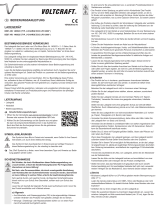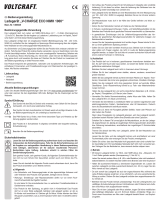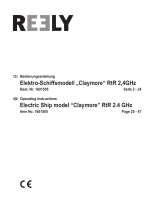Page is loading ...
Page is loading ...
Page is loading ...

Operating instructions
Charger "V-CHARGE ECO NIMH 1000"
Item no. 1460625
Intended use
The charger is designed to charge NiMH/NiCd batteries with 1 - 8 cells (nominal voltage
1,2 to 9,6 V). Observe the instructions on charging current, charging capacity, as well as the
instructions in chapter "Technical Data" at the end of this operating instructions.
Thechargerhasabuilt-inpowersupplyunit(operatingvoltage100-240V/AC,50/60Hz);
connect the charger to an appropriate mains socket for voltage/power supply via the supplied
power cable.
For safety and approval reasons, you may not convert and/or alter the product. If you use the
product for purposes other than those described above, the product may be damaged. Moreo-
ver,theimproperuseinvolvesriskssuchasshort-circuits,re,electricshocks,etc.Pleaseread
the operating instructions carefully and do not discard them. If you pass the product on to a third
party, please hand over these operating instructions as well.
This product complies with the applicable National and European Regulations. All names of
companies and products are the trademarks of the respective owners. All rights reserved.
Package Contents
• Charger
• Power cable
• Operating Instructions
Up-to-date operating instructions
Download the latest operating instructions via the link www.conrad.com/downloads or scan the
QR code. Follow the instructions on the website.
Explanation of Symbols
The lightning symbol inside a triangle is used when there is a potential risk of perso-
nal injury, such as electric shock.
An exclamation mark in a triangle indicates important instructions in this operating
manual which absolutely have to be observed.
Thearrowsymbolisusedwhenspecictipsandinformationonhandlingsarepro-
vided.
The product is designed according to protection Class II (reinforced or double insu-
lation, protective insulation).
Observe the operating instructions!
Safety Instructions
Please read the operating instructions carefully and pay particular attention
to the safety instructions. We do not assume liability for injuries/material
damages resulting from failure to observe the safety instructions and the
information in these operating instructions regarding the proper handling of
the product. Furthermore, in such cases, the warranty/guarantee will be null
and void.
Dear Customer, the following safety instruction is intended not only for the protection
of your health, but also for the protection of the product.
Therefore, please read the following points very carefully before connecting and
usingtheproductforthersttime.
a) General Information
• Unauthorisedconversionand/ormodicationoftheproductisnotallowedforsa-
fety and approval reasons. Never dismantle the product.
• Maintenance, settings work or repairs may only be carried out by a specialist/
specialised workshop.
There are no components for you to adjust or maintain within the device.
• The product is not a toy and should be kept out of the reach of children! The
product may only be set up, used or stored in places that are not accessible to
children. The same applies to rechargeable batteries. Children could short-circuit
the rechargeable battery/battery pack, which may cause an explosion. This pre-
sents a danger to life!
• The construction of the product corresponds to the protection-class II (double or
reinforced isolation). Pay attention that the insulation (of the casing or the output
cable) is neither damaged nor destroyed.
• The charger is designed to be operated with a mains socket with supply voltage of
100 - 240 V/AC, 50/60 Hz. Never operate it on a different voltage.
• The outlet must be located in direct proximity to the device and easily accessible.
• Do not pull the mains plug from the mains socket by pulling on the cable!
• In schools, educational centres, hobby and self-help workshops, the operation of
the product must be supervised by trained employees.
• On industrial sites, the accident prevention regulations of the association of the
industrial workers' society for electrical equipment and utilities must be followed.
• Do not leave the packaging materials unattended. It may become a dangerous
plaything for children!
• If in doubt about how to connect the device correctly, or should any questions arise
that are not answered in these operating instructions, please contact our technical
service or another specialist.
b) Location for Use
• The product may only be used in dry, enclosed spaces. It may not get wet or
damp;otherwisetheremaybedangerofelectricshock!
Do not use the charger within a vehicle.
• Selectastable,at,clean,sufcientlylargeplaceforthecharger.
Donotplacethechargeronaammablesurface(e.g.carpet,tablecloth).Always
useasuitable,non-ammable,heatproofbase.
Do not place the charger on surface of valuable furniture without suitable protec-
tion. The impact of heat could lead to colour or material changes.
Keepthechargerawayfromeasilyammablematerials(e.g.drapes,paper),li-
quids (e.g. gasoline) or gases.
• Avoid direct sunlight, strong heat or cold. Keep the charger away from dust and
dirt.
• Donotuseintheimmediatevicinityofstrongmagneticorelectromagneticelds,
transmitter aerials or HF generators. This can impact the electric control system.
• Donotplaceanycontainerslledwithliquid,e.g.vasesorplants,onornextto
the charger.
If these liquids get into the interior of the charger, the charger will be destroyed,
andthereisalsothegreatestdangerofareoranexplosion.
In this case, immediately switch off at all poles the mains socket that the charger
is connected to (switch off the corresponding circuit breakers or remove the safety
fuse, then switch off the corresponding earth leakage circuit breaker).
Afterwards, remove the battery from the charger and pull the power plug out of
the mains socket.
Let the battery and the charger dry, then have them checked by a specialist work-
shop or dispose of them in an environmentally compatible manner.
• Make sure that the power cable is not pinched or damaged by sharp edges. A
damaged power cable must not be used! Place the cable so that nobody can trip
over it.
c) Operation
• Only NiCd or NiMH batteries or battery packs with 1 to 8 cells (nominal voltage
1,2 to 9,6 V) can be charged with this charger.
Never charge other types of rechargeable batteries (for e.g. LiPo or lead batteries)
ornon-rechargeablebatteries.Thereisagreatriskofreorexplosion!
• Maintainenoughdistancetoammableobjects.Allowenoughdistancebetween
thechargerand the battery (minimum 20 cm);neverplace the battery on the
charger.
• As both the charger and the battery heat up during the charge/discharge proce-
dure,itisnecessarytoensuresufcientventilation.Nevercoverthechargerand/
or the connected battery.
• Do not operate the appliance when it is unattended. Although there is a wide range
of comprehensive safety mechanisms on the device, it is impossible to exclude the
possibility of malfunctions or problems occurring while charging a battery.
• When you work with the charger or rechargeable batteries, never wear metallic
or strongly conductive materials, such as jewellery (necklaces, bracelets, rings
orsimilarobjects).Ashortcircuitatthebatteryorchargerposesadangerofre
and explosion.

• Do not leave the batteries connected to the charger when the charger is not
needed.
Disconnect the charging set from the mains voltage. Pull the mains plug out of the
mains socket. Afterwards, keep the product in a clean, dry, and out of children's
reach place.
• Only use the device in a moderate climate, do not use it in a tropical climate.
For more information on acceptable environmental conditions, see the chapter
"Technical Data".
• Never use the product immediately after it has been brought from a cold room
into a warm one. The resulting condensation may lead to malfunctions or damage
under certain circumstances! Furthermore, this could cause a lethal electric shock!
Allow the charger (and the battery/batteries) to reach room temperature before
connecting the charger to the power supply and using it. This may take several
hours!
• Please handle the product carefully. The product can be damaged if crushed,
struck, dropped even from a low height or subjected to mechanical pressure and
vibrations.
• If it can be assumed that safe operation is no longer possible, the product must
be turned off and precautions are to be taken to ensure that it is not used unin-
tentionally.
It can be assumed that safe operation is no longer possible if the product is visibly
damaged, the product does not work at all, if it was stored long-term in unfavoura-
ble conditions, or if it was exposed to heavy loads during the transport.
d) Handling Rechargeable Batteries
• Keep rechargeable batteries out of the reach of children. Always keep rechargea-
ble batteries out of the reach of children.
• Do not leave accumulators lying around openly. Children or pets may swallow
them. In such a case, call a doctor immediately!
• Accumulatorsmustneverbeshort-circuited,takenapartorthrownintore.There
isariskofreandexplosion!
• If your skin comes into contact with leaking or damaged batteries, you may suffer
burns. Thus you should use suitable protective gloves.
• If any battery connector cables need to be cut to size (e.g. if the battery is supplied
without a connector plug), cut each cable individually to prevent a short circuit
occurring.Riskofreandexplosion!
• Only use the charger to charge the batteries with the suitable battery technology
(NiCd or NiMH). Never use this device to charge other types of rechargeable bat-
teriesornon-rechargeablebatteries.Thereisariskofreandexplosion!
Non-rechargeable batteries are meant to be used once only and must be disposed
of when empty. Charge rechargeable batteries intended for that use only.
• Batteries must not get damp or wet.
• Neverdamagetheexteriorofabattery.Thereisariskofreandexplosion!
• Never charge/discharge rechargeable batteries unattended.
• Never charge/discharge a battery directly in the model. First, remove the battery
fromthemodel;separateitcompletelyfromthespeedcontrollerorautopilot.
• Please observe the correct polarity (plus/+ and minus/-) when inserting the rechar-
geable battery into the charger or into the model (for e.g. an autopilot). Should you
connect the battery incorrectly, not only will the model be damaged but also the
battery.Thereisariskofreandexplosion!
• Do not charge any battery that is still hot (e.g. caused by high charge current from
the model). Allow the battery to cool down to room temperature before attempting
to charge it again.
• Never charge/discharge damaged, leaking or deformed batteries. This can result
inareorexplosion!Disposesuchunusablebatteriesinanenvironmentallycom-
patible manner.
• Never use battery packs that are composed of different types of cells.
• Recharge the accumulators about every 3 months, as otherwise there may be
a total discharge due to self-discharge, which makes the accumulators useless.
• Disconnect the battery from the charger when the battery is fully charged.
• Improper use (too high charging current or incorrect polarity) can supercharge or
damage the rechargeable battery. In the worst case, the rechargeable battery can
explode and thereby cause serious damage.
• Never damage the battery, never let the battery fall, do not pierce the battery with
any objects! Avoid applying any mechanical loads to the battery, never pull on the
battery'sconnectorcables!Thereisariskofreandexplosion!
These guidelines must also be observed when the battery is inserted into the
model (if the model is removed, for example).
• Ensure that the battery does not overheat during usage, recharging, discharging,
transport or storage. Do not place the battery adjacent to sources of heat (e.g.
cruise control, motor), keep the battery away from direct sunlight. There is a risk of
reandexplosionifthebatteryoverheats!
• The battery must not reach a temperature higher than + 60 °C (observe additional
instructions of the manufacturer with other limitations as applicable!).
• If there are damages on the battery, do not use it any more. Do not recharge it.
Thereisariskofreandexplosion!
Only touch the battery with care, use suitable protective gloves.
Dispose of the battery in an environmentally compatible manner.
• When there is no information available from the battery manufacturer about the
maximum permitted charging current, charge the NiCd/NiMH battery with a char-
ging current of max. 1C. This means that the charging current may not exceed
the capacity value imprinted on the battery (e.g. battery capacity 1000 mAh, max.
charging current 1000 mA = 1 A).
• Observe the additional safety instructions from the manufacturer of the batteries/
battery packs that you use.
Connections and Control Elements
1 Mains supply socket
2 Plug of the charging cable
3 Power LED
4 Status LED
Installation and Operation
• Connect the power socket (1) to an appropriate mains socket via the supplied power cable.
The Power LED (3) lights up green when the charger is ready for operation.
• Placethechargeronalevel,at,stablesurface.Protectvaluablefurnituresurfacesbyusing
a suitable mat to prevent scratches, pressure points or discolourations.
• The casing of the charger heats up during operation. Make sure that the charger is always
adequatelyventilated;nevercoveritwhileinoperation.
• Connect the battery that you want to charge with the plug (2) of the charger. Observe the
correct polarity (plus/+ = red cable, minus/- = black cable).
• The charging process starts immediately after the battery is connected.
• A LED status indicator (4) indicates the function of the charger:
LEDisoff: Nobatteryidentied
LED lights up red: The charging process is under way
LEDlightsupgreen: Thechargingprocessisnished
LEDashesred: Anerrorisindicated(fore.g.wrongpolarityforthebattery,battery
deep-discharged, cell voltage too high, etc.)
Themax.chargingcapacityofthechargerinuencesthepossiblechargingcurrent.
Therefore, the charging current is lower for an 8-cell battery than for a 2-cell battery.
• When the charging process is done, remove the battery from the charger.
• Now, either connect another battery for charging, or disconnect the charger from the mains
voltage. Pull the mains plug out of the mains socket. Keep the product in a cool, dry, dust-free
place out of the reach of children.

This is a publication by Conrad Electronic SE, Klaus-Conrad-Str. 1, D-92240 Hirschau (www.conrad.com).
Allrightsincludingtranslation reserved. Reproduction by any method,e.g.photocopy,microlming, or the capture in
electronic data processing systems require the prior written approval by the editor. Reprinting, also in part, is prohibited.
This publication represent the technical status at the time of printing.
Copyright 2016 by Conrad Electronic SE. *1460625_V2_0616_02_VTP_m_en
Care and Cleaning
• A connected battery must be unplugged before cleaning. Disconnect the charger from the
mains voltage. Pull the power plug out of the mains socket.
• Never use abrasive cleaning agents, cleaning alcohol or other chemical solutions, since the-
se could damage the housing or even impair operation.
• Use a dry, lint-free cloth to clean the product.
Disposal
a) Product
Electronic devices are recyclable material and do not belong in the household was-
te. Dispose of the unserviceable product in accordance with the relevant statutory
regulations.
b) Batteries/Rechargeable batteries
As the end user, you are required by law (Battery Ordinance) to return all spent batteries/
rechargeablebatteries;disposaloftheminthehouseholdwasteisprohibited.
Batteries/rechargeable batteries contain harmful materials and are labelled with the
symbol shown to indicate that disposal in the household waste is forbidden. The
symbols of the critical heavy metals are: Cd=cadmium, Hg=mercury, Pb=lead (the
marking can be seen on the battery/rechargeable battery, e.g. underneath the refu-
se bin symbol shown on the left).
Youcanreturnyourusedbatteries/rechargeablebatteriesfreeofchargeattheofcialcoll-
ection points of your community, in our stores, or at places where batteries or rechargeable
batteries are sold.
Youtherebyfullyourstatutoryobligationsandcontributetotheprotectionoftheenvironment.
Technical Data
Operating voltage ......................... 100 - 240 V/AC, 50/60 Hz
Protection class ............................ II
Charger plug ................................. Tamiya type
Suitable battery types ................... NiMH, NiCd
Number of cells ............................. 1 - 8
Battery capacity ............................ 500 - 5000 mAh
Charging current ........................... max. 1 A
Charging capacity ......................... 10 W
Float charging current ................... 50 mA
Charging process ......................... Delta-U
Short-circuit protection .................. yes
Overload protection ...................... yes
Ambient conditions ....................... Temperature +10 °C to +40 °C, air humidity 0% to 90%
relative, not condensing
Dimensions (L x W x H) ................ 97.6 x 56 x 28.8 mm
Weight .......................................... 100 g
Page is loading ...
Page is loading ...
Page is loading ...
Page is loading ...
Page is loading ...
Page is loading ...
-
 1
1
-
 2
2
-
 3
3
-
 4
4
-
 5
5
-
 6
6
-
 7
7
-
 8
8
-
 9
9
-
 10
10
-
 11
11
-
 12
12
Reely 2111254 Operating instructions
- Type
- Operating instructions
- This manual is also suitable for
Ask a question and I''ll find the answer in the document
Finding information in a document is now easier with AI
in other languages
- français: Reely 2111254 Mode d'emploi
- Deutsch: Reely 2111254 Bedienungsanleitung
- Nederlands: Reely 2111254 Handleiding
Related papers
-
 Reely 2103649 Operating instructions
Reely 2103649 Operating instructions
-
 Reely 1559975 Operating instructions
Reely 1559975 Operating instructions
-
 Reely 1601505 Operating instructions
Reely 1601505 Operating instructions
-
 Reely 1976297 Operating instructions
Reely 1976297 Operating instructions
-
Reely 1592467 Operating instructions
-
 Reely 1527213 Operating instructions
Reely 1527213 Operating instructions
-
 Reely 1661756 Operating instructions
Reely 1661756 Operating instructions
-
 Reely RC model speedboat for beginners 100% RtR 335 mm Operating instructions
Reely RC model speedboat for beginners 100% RtR 335 mm Operating instructions
-
 Reely 1563376 Operating instructions
Reely 1563376 Operating instructions
-
 Reely 1407343 Operating instructions
Reely 1407343 Operating instructions
Other documents
-
VOLTCRAFT 1413030 Operating Instructions Manual
-
VOLTCRAFT V-CHARGE ECO LIPO 1000 Operating Instructions Manual
-
VOLTCRAFT V-CHARGE ECO LIPO 4000 Operating Instructions Manual
-
VOLTCRAFT IPC4 Operating Instructions Manual
-
VOLTCRAFT CC-1 Operating Instructions Manual
-
VOLTCRAFT CC-2 Operating Instructions Manual
-
VOLTCRAFT V-Charge Field 200 Operating instructions
-
VOLTCRAFT CHARGE MANAGER 2024 Operating Instructions Manual
-
VOLTCRAFT B8 Operating Instructions Manual
-
VOLTCRAFT B6 Operating Instructions Manual




















